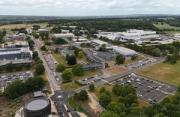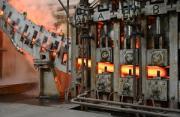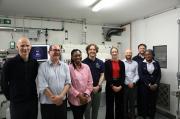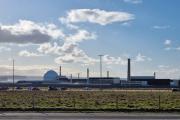Dounreay Bulletin - Issue 11
21st September 2006
REACTOR CONTROL ROOM IS CONSIGNED TO HISTORY.
What was once the hub of the next generation of nuclear power plant, a hive of activity buzzing with the thrill of ground-breaking technology, is now in stark contrast an empty shell.
The former control room at the Prototype Fast Reactor became redundant when it shut down in 1994. Twenty years earlier, when it came into service, PFR was the forerunner to a new generation of commercial reactors but, by the late 1980s, economic factors signalled its demise.
The stripping out of the 300 sq. metre control room started in 2002, with the removal of the many large complex control panels and operating terminals which were used to run the plant. Some of these have been retained for historical purposes as a reminder of the pioneering design and technology used to develop the fast reactor programme at Dounreay. The majority of the refurbished area is being transformed into temporary office for decommissioning staff.
PFR used 1500 tonnes of liquid sodium metal to cool the reactor core and transfer the heat through three secondary circuits to a steam-generating plant for electricity production. All the nuclear fuel was removed from the reactor following its closure and the next phase of decommissioning is to dispose of the sodium. To date 1150 tonnes of sodium has been destroyed, with the remainder scheduled for destruction before April 2007.
TRIBUTES PAID TO GENERATIONS OF STUDENTS WHO PIONEERED NATION'S ELECTRICITY
Norman Harrison, UKAEA's acting chief operating officer, paid tribute to generations of students in the Highlands who went on to play a key role developing the technology that now provides Britain with more than a fifth of its electricity. Speaking at the annual prize-giving in Wick of North Highland College, part of the University of the Highlands and Islands Millennium Institute, he also acknowledged that there had been mistakes in the industrial processes that supported the scientific experiments and breakthroughs achieved at Dounreay. More: http://www.ukaea.org.uk/news/2006/15_09_06.html
BE AWARE, BE SEEN, BE SAFE
New rules about the wearing of personal protective equipment are being introduced at Dounreay to reduce the risks to workers and visitors from the increasing amount of demolition and construction activity now taking place. From October 1, high visibility jackets or vests will be mandatory in all outdoor areas of the site at all times. In most areas of the site beyond the administrative centres near the entrance, it will also be mandatory to wear hard hats, safety footwear and other protective equipment. The new rules apply to both visitors and staff. Click on the attached to view a map showing the PPE requirements for all areas of the site from October 1. http://www.ukaea.org.uk/downloads/dounreay/ERO_P30_06.pdf
SAFETY STAND-DOWN AFTER LOST TIME ACCIDENT
All decommissioning work was put on hold for several hours on September 15 while a safety stand-down took place. This allowed every worker on site to focus exclusively on their safety and the safety of their workplace, and enabled management to communicate the importance it attaches to rules about safe working practices. The stand-down was ordered after a number of minor industrial accidents, culminating in a broken shoulder when an employee was struck by a loose scaffolding pole.
DFR VENTILATION STRIP-OUT BEGINS
Following the successful installation of new ventilation to support decommissioning of the Dounreay Fast Reactor, stripping out of the redundant 50-year-old ducting and associated equipment is well underway. This work has been accelerated from future years through efficiency savings achieved by the DFR team.
Mitsui Babcock Energy Ltd is working on the project for UKAEA, with support from Johnson Controls Ltd, RWE Nukem and Caithness Scaffolding. As part of a new initiative, UKAEA has introduced an incentive scheme for safe and successful completion of the project under budget, which would reward the primary contractor with a share of any savings made as a result.
Work began on the �150,000 project in August and is expected to be complete by the end of the year.
OFFSHORE PARTICLES SURVEY IS COMPLETE
UKAEA has completed a three-month programme of offshore monitoring surveys to improve understanding of the location of irradiated fuel particles in off-shore sediments using a remotely-operated monitoring device. The results are being compiled and a preliminary report has been sent to the Dounreay Particles Advisory Group and Scottish Environment Protection Agency. More: http://www.ukaea.org.uk/news/2006/07_09_06.html
TWO MORE BEACHES TO BE SURVEYED
In the near future, UKAEA will be carrying out non-statutory surveys of two more beaches as part of its monitoring for radioactive particles in the marine environment. The Groundhog monitoring system will be deployed on the beaches at Murkle and Peedie Sands, both near Dunnet Head. A single, small particle was found on a nearby beach at Dunnet in March 2005. None was found during a follow-up survey.
APPRENTICE AND TRAINEE CERTIFICATE PRESENTATIONS
Apprentices and trainees from UKAEA and other contractors at Dounreay who successfully completed their training received their certificates at a presentation ceremony on September 15 at the Pentland Hotel, Thurso. Sixteen final-year apprentices and trainees from UKAEA, JCL and Nukem received their certificates.
John Farquhar, regional director of the Nuclear Decommissioning Authority, was the guest speaker. He congratulated all the apprentices and trainees for the hard work they had put in to achieve their certificates, and wished them all the best in their chosen careers. "The skills you have learned are very important to the NDA because they underpin the civil nuclear decommissioning programme at Dounreay and elsewhere in Britain," he told them.
UKAEA OFFERS VIEWFIRTH SITE FOR COMMUNITY USE
UKAEA, on behalf of the Nuclear Decommissioning Authority, is offering to the local community an area of land in Thurso previously occupied by the Dounreay Sports and Social Club. UKAEA has sought the advice of the Dounreay Stakeholder Group on suitable uses for the property and is encouraging the community to come up with proposals to take over the land. The site includes a Victorian ex-schoolmaster's house which was converted to a sports and social club for incoming workers in 1958 and which may need to be demolished.
VISITOR CENTRE ENJOYING ANOTHER BUSY SEASON
The ever-popular Dounreay Visitor Centre has so far welcomed well over 8,000 visitors through its doors since opening for the 2006 season at Easter. The centre explains to visitors the remarkable story of the pioneers who developed the fast breeder programme at Dounreay over 50 years ago, and the major clean-up programme now underway to restore the environment.
The centre recently hosted initiatives in support of Safe Highlanders, Doors Open Day, Caithness Arts Week and Scottish Archaeology Month. Admission is free and it is open daily from 10am to 4pm through to the end of October, with trained guides on hand plus a tea bar serving snacks and refreshments.
DOUNREAY WORKERS VOLUNTEER AS AMBASSADORS
Engineers working at Dounreay have enrolled in the Science and Engineering Ambassadors (SEA) scheme, as part of the Science, Engineering, Technology and Mathematics network (SETNET). SETNET is a UK-wide charity, which promotes science, technology, engineering and mathematics in schools to ensure that there are sufficient school-leavers entering these fields. This will formalise the already considerable support given by UKAEA and its contractors to the local community's youth.
Ambassadors are people with science, technology, engineering and maths skills who use these skills in their day jobs. They help schools on a voluntary basis in many diverse ways. They may go into the schools to give lectures, or run after-school clubs, give careers advice or provide mentoring support, or assist with local events such as science fairs. Their enthusiasm for their subject can motivate pupils to stay on in education after the age of 16 and to choose an engineering or scientific career.
The Ambassadors at Dounreay will be co-ordinated by SETPOINT Scotland North, which covers the whole of Scotland north of the River Tay, including Shetland, Orkney and the Western Isles. SETPOINT organises police vetting, and supports the Ambassadors to ensure that they can give maximum value to the schools.
Related Businesses
Related Articles
UKAEA develops 3D printing for fusion components
At its recently opened Central Support Facility (CSF), UKAEA has commissioned an electron beam additive manufacturing machine that can be used to incorporate tungsten into components, alongside a selective laser manufacturing machine. Fusion can play a key role in a global low carbon energy future.Advancing Fusion Remote Maintenance: Industry Collaboration Driving Innovation
As part of the Fusion Futures (FF) programme, UKAEA's Remote Applications in Challenging Environments (RACE) has partnered with industry leaders to develop two groundbreaking technologies for remote maintenance in fusion energy engineering. Thanks to FF funding, industry has taken the lead in maturing UKAEA technology concepts—delivering real-world solutions that enhance operational autonomy and reduce maintenance burdens in extreme environments.UKAEA launches International Fellowships Scheme for fusion
UKAEA has launched the International Fellowships Scheme, an initiative to help expand the global talent pool supporting the fusion industry. The scheme is part of the UKAEA's Fusion Opportunities in Skills, Training, Education and Research (FOSTER) Programme, which aims to train, support, and empower the next generation of professionals, who will help deliver fusion power to the grid.Kyoto Fusioneering and Astral Systems join Culham fusion hub
UKAEA's Culham Campus welcomes Kyoto Fusioneering and Astral Systems as its latest tenants. Two pioneering companies, Kyoto Fusioneering and Astral Systems, have joined the growing cluster of fusion technology and AI organisations at United Kingdom Atomic Energy Authority's (UKAEA) Culham Campus.
Fusion-grade Steel Produced At Scale In UK-first
Researchers achieve 10x production cost savings for reduced activation steel. A United Kingdom Atomic Energy Authority (UKAEA) working group has successfully demonstrated the industrial scale production of fusion-grade steel.
UKAEA To Lead The Creation Of A Robotics And AI Cluster
UKAEA will lead the creation of a new £4.9m nuclear robotics and artificial intelligence cluster across Cumbria and Oxfordshire. The robotics and AI cluster was announced by UK Research and Innovation (UKRI) as one of seven new projects to kickstart economic growth and address regional needs: www.ukri.org The robotics and AI cluster will link Cumbria and Oxfordshire to accelerate the decommissioning of the UK's legacy nuclear fission facilities and keep people out of hazardous environments.
Diamonds Are Forever? World-first Carbon-14 Diamond Battery Made In Uk
The world's first carbon-14 diamond has been produced with the potential to provide power for thousands of years. Scientists and engineers from the UK Atomic Energy Authority (UKAEA) and the University of Bristol have successfully created the world's first carbon-14 diamond battery.
UKAEA Monthly Newsletter Latest Edition
Find out what has been happening at UKAEA in our monthly newsletter. Read about our recent activities and upcoming events.
UKAEA Newsletter - Edition 11 Published Today
Find out what has been happening at UKAEA in our monthly newsletter. Read about our recent activities and upcoming events.
Corwm Visits Dounreay Nuclear Site
Members were given an overview of the scale of the problem and challenges faced in the decommissioning of the site. In the last week of March 2024, several members of CoRWM led by the Chair, Sir Nigel Thrift, made the long journey up to the North of Scotland to visit the Dounreay nuclear site, now managed by Nuclear Restoration Services.
